Katyaak Kiana, Alaska
 Inez Ayagiaq Black tells a story about how Kiana got started.
Inez Ayagiaq Black tells a story about how Kiana got started.
(This interview was originally recorded in the Inupiaq language, and was translated into English and printed in Lore of the Inupiat: The Elders Speak, Volume 3. This bilingual book was edited by Linda Piquk Lee, et al and published by the Northwest Arctic Borough School District in 1992. This story is reprinted here with permission from the publisher.)
Inez Ayagiaq Black was born at Sealing Point, near Kotzebue, on June 25, 1919, to Carl Argak and Ellen Nauyaq (Sheidt) Luther. She is the eldest of three sisters and two brothers. Inez attended school at Noatak and graduated from the 8th grade. When she was not in school, she did housekeeping for the teachers, earning two dollars a week. Every spring Inez and her family went to the coast from Noatak to hunt seal, walrus, ugruk and beluga. They traveled to Kotzebue to trade their game for other food and supplies. Also, before reaching Kotzebue, they made new mukluks and traded them for food. Inez was first married to Charlie Uqaq Sheldon in 1935. He passed away and in 1959, she married Johnson Black. Her children are Mary Qilauraq Atoruk, Irene Nataaġnaq Tuckfield and adopted out is Mary Jane Iļusriñ Downey. Inez became a midwife in 1946 while living in Noorvik. She learned by helping other midwives. She is known for assisting in the delivery of many Kiana residents. In 1975--76, she worked for the Maniiļaq Association as a researcher. She interviewed elders from Kiana and willingly shared her knowledge of Inupiaq culture and history. Inez passed away in the fall of 2002 and is greatly missed by her many friends and family.
See also: Tommie Sheldon's Kiana History, and The Naming of Kiana.
I am going to tell you how Kiana got started. Since I did not know much about that, I worked hard going from elder to elder to find out about it.
Before Kiana was established there were Inupiat living along the river and fishing and hunting all through the area. For their settlements people selected sites which were ideal for fishing and hunting. Originally there were two families living over by the slough at a place called Aksraksaġvik. This was on the north side of the present village. There were other families at Piuļgich (Kittyways) and further upriver. You can still find the ruins of old places up that way.
People lived in sod houses called ivrulgich. They did not live in the same place all the time. They made a new house every winter and in the summer they built a summerhouse. They would excavate a spot, frame it with wood, and cover it with sod. They were building new dwellings all the time even though it required hard work. Whenever it was time to leave a house, they took all their belongings with them because they knew that they would not return to that house.
Also, whenever a person died in a house, they would abandon it because they thought they would catch a contagious disease if they went back. They also considered it taboo to live in a house where someone had died. In those days they did not build coffins or dig graves to lay the dead to rest. If possible, they wrapped the body and placed poles around it in the shape of a teepee.
The first white men came up the river by boat in 1898. The name of the boat when pronounced in Inupiaq came out as 'Iknis Fua' (Agnes Four). After two or three years had gone by, some other white men came. It was around 1901 or 1902. When they came back, they settled where Kiana is now. There were only a few of them at that time. Some of the elders said that there were only three.
When the white men settled here, they didn't build sod huts. They built log cabins in those days. I remember seeing some of those old log houses still standing, but they're gone now. When the white men came, they were 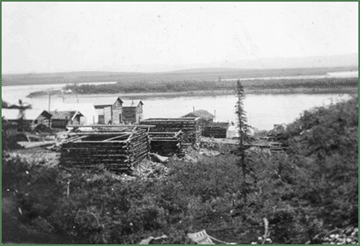 young. Some of them married Inupiaq women. As more white men came, more Inupiat decided to move to Kiana. The white men settled where Kiana is presently, while the Inupiat settled on the north side. Where the Inupiat lived was called a village, but this place was called a town.
young. Some of them married Inupiaq women. As more white men came, more Inupiat decided to move to Kiana. The white men settled where Kiana is presently, while the Inupiat settled on the north side. Where the Inupiat lived was called a village, but this place was called a town.
When the white men who married local women had children and the children started growing up, the white men built a school house made of logs. Some elders say that when the school was first built, only the children of mixed blood attended. Later, the full-blood Eskimo children attended also. Back then everyone had just an Eskimo name. But when children started attending school, the teachers gave them English names too.
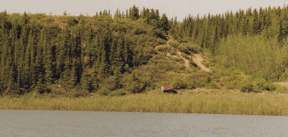 As the village grew, people built a log-cabin church. It was located in the old village on the north side. They dismantled it recently after I moved here to Kiana. All the Inupiat moved here to town once it was set up, but the old site is still there. We still call it the "old village." People still tie up their boats there at Iqsiibvik because it is sheltered from the wind.
As the village grew, people built a log-cabin church. It was located in the old village on the north side. They dismantled it recently after I moved here to Kiana. All the Inupiat moved here to town once it was set up, but the old site is still there. We still call it the "old village." People still tie up their boats there at Iqsiibvik because it is sheltered from the wind.
There are only a few old houses and caches standing where the people lived long ago. Many of those old timers have died and only a few are left. I've asked them when Kiana was settled, but they don't remember the exact year. When they built the church over there in the old village, the Inupiat didn't know about God. Their first preacher was a single woman named Miss Hunnicutt. Since she was a missionary, she started teaching some of the local Inupiat how to be preachers too.
In those days before the white man came, the Inupiat didn't get married by a judge or a preacher. When a man wanted a girl, even if she didn't want him, he went himself to get her or he sent someone else to get her. Then he 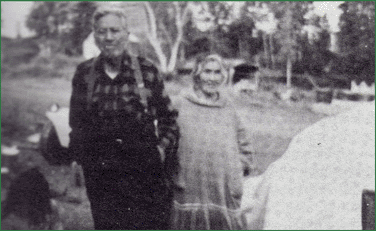 took her to his home as his wife. They lived in the home of his parents as husband and wife. This was their custom because before they heard about the gospel, their only gods were the shamans. Besides the shamans, some people may have had fetishes before they knew about God. Shamans were the ones people turned to when they were sick. They got paid for whatever it was they did.
took her to his home as his wife. They lived in the home of his parents as husband and wife. This was their custom because before they heard about the gospel, their only gods were the shamans. Besides the shamans, some people may have had fetishes before they knew about God. Shamans were the ones people turned to when they were sick. They got paid for whatever it was they did.
People in those days did not have medicine as we do now. Instead, cranberries were used when people had a sore throat. They used leaves and tree gum as salves for their cuts. For bandages they used partially tanned caribou hide.
If a child had a sore mouth, they let him or her chew a piece of dried swallow. This remedy is still used today. If they had an upset stomach, he or she was given dried porcupine droppings or wild rhubarb. For a tooth-ache people would put the dorsal fin of a grayling between the teeth that hurt. The pain would stop when they did that. That's how a grayling fin was used as medicine. If someone had a deep cut, people would wrap it with caribou hide after applying some fish oil and then bind the bandage with sinew. Blood letting was practiced to cure headaches. And if someone had eye pain, they would make a cut on the bridge of the nose between the eyes and let it bleed because they thought that otherwise that person might go blind.
After the white men had been here a while, they decided to give the place a name. The point across from the village had always been called Qaiyaana. When people started writing letters and needed an address, they must have named it Kiana because they probably could not pronounce Qaiyaana properly. Some elders say that the place was named after a young lady by the name of Qaiyaana.
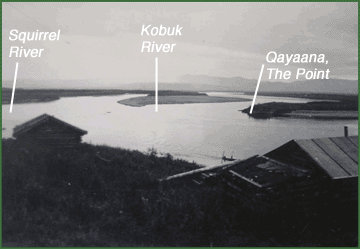 It might also have gotten its name from katyaak. In Inupiaq katyaak means "fork of the river." This is still the name we use where the three rivers flow together here, the Squirrel River, the Iqmalitļuŋaq Channel, and the Kobuk River. The point across the river has always been called Qaiyaana. When we first moved here, that point was longer, but erosion has worn it away.
It might also have gotten its name from katyaak. In Inupiaq katyaak means "fork of the river." This is still the name we use where the three rivers flow together here, the Squirrel River, the Iqmalitļuŋaq Channel, and the Kobuk River. The point across the river has always been called Qaiyaana. When we first moved here, that point was longer, but erosion has worn it away.
Back then there was no landing field for airplanes. Mail did not come by plane in those days. In the winter they brought mail by dogsled. I have heard that the one who brought mail from Kotzebue was Qaiyaaqpak. During the winter he brought mail all the way up the river once or twice by dogteam. He stopped at different settlements along the Kobuk River all the way to the Upper Kobuk area. That mailman indeed left a legacy. Today, some Eskimos teasingly call anyone named Qaiyaaqpak "mailman," because they bear the same name as that first mailman.
When we first came here and there was no landing field, the airplane used to land across the river on the sandbar. In the wintertime it would land on the ice. So the white men called the village Kiana, while the original name of that point across from the village was Qaiyaana.
After the white men had been here for awhile, some of them wanted to look for gold along the creeks feeding into Squirrel River. There are many creeks flowing up there between the mountains. Klery Creek, Central Creek, Martin Gulch are some of the names that the men gave those creeks.
In Klery Creek one of the men found gold. He didn't try to mine the gold without a permit. He went to Kobuk to get a permit from a judge who was up there. That is another name that was adapted. The name Kobuk originated from the Eskimo name Kuuvak.
When other white men heard that gold had been discovered in Klery Creek, they came to look for gold too. They panned for it. During the winter they used boilers to thaw the ground. Then they gathered the mud and stock-piled it until the summer when they washed the mud away with water. They waited for summer to thaw everything out so they could wash the gold out of the mud.
Later, when barges began making trips up the river, the miners ordered a gold dredge to mine with. The dredge is still up there. I've seen it. It is not used anymore. After we moved up here around 1949, they could not find any more gold so they quit mining. They had already quit using the dredge when the gold ran out. Some of the young Inupiat men helped them mine. They were learning how to earn things from the white men. They probably earned less than one dollar an hour.
When the young men started working, their life-style changed. They didn't eat only Eskimo food. Their clothing changed. They didn't use winter furs all the time, like the fur pants they used to wear. Our ancestors used all fur clothing, no cloth. When the white man came, people even acquired canvas tents. All this made life easier for the Inupiaq people. They even started eating white man's food.
Before that there were times when people did not catch enough fish even though they worked hard at hunting and fishing. If they were not able to store much food and berries, even though they had also worked hard to snare animals, they sometimes would go hungry in the winter. After all, one could hardly hunt during a blizzard. So when it got get really stormy, the women went out and set snares. In those days they probably used snares made of sinew.
When people first got white man's food, they did not know how to prepare it. When they got flour they didn't know how it could be prepared and eaten. Some people put it on a plate and mixed it with seal oil, water, and sugar and ate it like that. When some people made tea, they put in too many tea leaves.
When the first miners came looking for gold, they brought all sorts of things with them, like guns, tents, and all kinds of hunting gear. People began to acquire these kinds of things and it made life easier for them. If we still tried to live the way people used to, we would starve to death because people don't do much fishing in the summer anymore. We all know that when the weather gets harsh in the winter, it's really not possible to do anything.
Now I'm going to tell you how people used to hunt and fish. Long ago, the only hunting weapons the Inupiaq men had were spears and bow and arrows. Because they had no rifles back then, they used rawhide ropes to make snares for caribou. The women snared for rabbits and ptarmigan using thinner rawhide strips and twisted sinew.
In the early fall once the rivers froze over, people would set out fish traps and also dip-net fish. Their tools and implements were not efficient. An ice pick, for example, was made of caribou antlers. When used to chop ice, it probably got dull very quickly. When they wanted to cut down trees to build fish trap weirs, they did not have modern axes like we do today. Their implements and knives were made of jade or flint. Even the women's ulu (Eskimo woman's knife) were homemade. If people got a lot of fish from their fish traps, they had a good winter.
In the spring women made nets of willow bark. They got their willow bark in the early spring when the willows are easy to peel. People had no clocks or calendars, but they knew exactly when the bark was just right for gathering. During the winter the women braided ropes and different kinds of twine from spruce roots. Then, in the summer the net was carefully stored in water to keep it from becoming dried out and brittle. The sinkers people used were made from caribou antler and their floats were carved from the wood of tree trunks.
Long ago boats were made of a wooden frame covered with birch bark. They had no outboard motors so they used paddles and poles. Some towed their boats with a rope from the river bank.
When trapping for wolverine and wolf, the men made traps from wood. In the fall and spring, the men left their wives to go to the North Slope to hunt Dall sheep. After being gone all summer, the men came home in late fall just before freeze-up. They also got caribou hides in the summer when the fur was just right for clothing. They spent the whole summer there. They also got marmot skins and other furs. The woman stayed behind to fish.
When women picked berries, rhubarb, or sourdock, they stored them in old seal pokes. Around here there are no seals so we could not use new pokes all the time. I heard that in the summer people from here would go to Kotzebue to trade for seal oil and other sea foods. They brought with them things that they caught here, like wolves or wolver-ines. That is what they would trade with. I wonder how long it took them to get to Kotzebue because it is a long way from Kiana. After they did their trading, they would begin the long journey back.
If we tried to hunt today the way they did long ago, I wonder if we would get any caribou and make it through the winter. Our young people have it so easy now, that they probably could not make it through a bad winter if they had to live the way people did in the past.
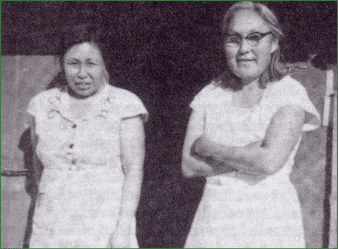 Modern life has spoiled us and life has become too easy. We have oil stoves and running water. We no longer have to take out slop buckets. This is what is making our children spoiled. They want to eat fast foods and wear the latest style of clothing, things that we never had when we were growing up. Now if clothes are not just right, people will complain about it. It was not like that in those days.
Modern life has spoiled us and life has become too easy. We have oil stoves and running water. We no longer have to take out slop buckets. This is what is making our children spoiled. They want to eat fast foods and wear the latest style of clothing, things that we never had when we were growing up. Now if clothes are not just right, people will complain about it. It was not like that in those days.
I wonder what we would do now if we had to use furs to make clothing or mukluks. During the summer in the old days it was taboo to handle a caribou hide when the fish were running. Even taking a little bit of hair off the hide could cause someone in the family to die because the taboos were so strong.
Once there was a child who wet a caribou-hide mat-tress. In those days people did not have diapers, but used soft moss instead. The woman whose child had wet the mattress, took it outside, wrung it out, and hung it up to dry during the fishing season. After she did that, death entered the camp. People knew it was because of the broken taboo, so they began to leave the camp. But even then, some died on the way. Some of those in their last throes were saved by a shaman who used his healing powers on them. In the summertime people never worked on fur clothing. They did all their sewing and working on skins only in the wintertime.
Many people today do not know how to make mukluks or fur clothing. If we had to live like our ances-tors, we would starve. Many young people don't even eat Eskimo food. A lot of them think only of junk food. They all wear western-style shoes. If for some reason we could not import all these things from the outside, our young people would end up suffering in order to survive. There is a prediction that some day people will once again have to struggle to survive.
That is how the village of Kiana was established. People have moved here from other settlements because it is an ideal fishing and hunting spot. Another reason is that in the fall, the migrating caribou pass close to the village. Today the population of Kiana has grown. People now live in low-cost housing. We even have a school. They even built a high school for us. The students once had to go out (to a boarding home) for high school can now go to school at home.
Houses have been built further away from the river. There is also a big airport. We are thankful for all these modern conveniences. We have electricity to give us light. In the old days people used fish-oil lamps. It must have been difficult to sew clothing in the old days with just a lamp like that. Sewing needles then were made of bone and thimbles were made of thick leather. Today we would find it difficult to sew under such circumstances.
In earlier times the Inupiat did not play basketball the way they do today. Back then, they played only Eskimo soccer. They made a ball out of a piece of caribou skin stuffed with caribou hair. It was very lively. People also played ayahaaq (cat's cradle), qiputaq (Eskimo horse-shoes), and also aakuu-aakuu (a team game to make one of your opponents laugh). People also engaged in contests of strength and skill which people perform today as Eskimo games.
So that is how Kiana came to be a village. It is a big village to us. Even large airplanes can land in the big airport. We are thankful for the white people who came here to help us. But, our young people should continue to learn their Eskimo language. We are glad that they are learning the Inupiaq at school because nowadays when we speak Inupiaq to children, many of them don't under-stand. Instead, they ask, "What do you mean?" This is such a contrast to the life we led as children. When we first went to school, they worked so hard to teach us English that if we uttered even a word in Inupiaq, they punished us by making us stand in a corner. Today this has changed. Now that it is permitted to speak the Inupiaq language in school, some of the children cannot speak it.
It would also be a good idea if the students were taught how to make mukluks and parkas. This would make it possible for them to survive just in case some-thing happens to the supply of imported clothing we get from the outside. After all, the old Eskimos have predicted that someday life will get hard again. It would be a good idea if our children were able to be self-sufficient so that they could clothe themselves and survive.
Our ancestors were creative and self-sufficient. They found a way to live even though there were no modern conveniences. They made everything by hand and worked to the best of their ability. The men were always busy. Whenever a husband and wife worked hard together, they probably lived like a rich couple. For example, in the legends we hear about an umialik, meaning a "rich man." (Literally, it means "someone with a boat.") People probably called them umialik when they had lots of caribou and wolverine skins.
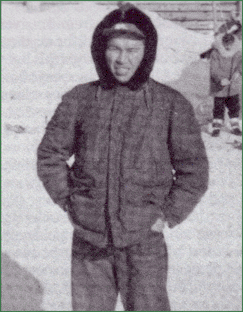 Today, everything costs money. It's not like the old days. When I was growing up, the supplies at the store were inexpensive compared to today. This was back when the white men first started shipping supplies to this area.
Today, everything costs money. It's not like the old days. When I was growing up, the supplies at the store were inexpensive compared to today. This was back when the white men first started shipping supplies to this area.
For example, coffee used to cost fifty cents a pound. A fifty -pound sack of flour was $3.50. Today the prices have gone up. Another thing is that if a person does not try to earn money, he will suffer because the goods at the store are so expensive. Nowadays, one has to either trap for furs or get a job.
People say that Aksik (sometimes spelled Oksik) was the settlement people lived in before the village of Noorvik was established. Apparently it had become a settlement because it was an ideal spot for dip-netting from a fish trap. According to the Noorvik residents, people used to dip-net a lot of sheefish in those days.
In 1914 people left Aksik to move to the new village of Noorvik. People moved to Noorvik from both Deering and Aksik. Later, they even build a hospital at Noorvik. People from surrounding villages went to that hospital to seek treatment. Some never made it back home. If they died there, they were buried in graves behind the village. Today those graves of people from other villages can still be seen at Noorvik.
Whenever I listen to the stories from the elders about life long ago, I am not sure that I could have survived in those days. For example, they told us that when times of suffering came and there was not enough food, the women and children did not eat much because they tried to feed what little food remained to the men in order to strengthen them. This most likely happened when the weather was even too harsh to set snares for small game.
Another thing they did was build small huts for adolescent girls away from the other homes. The young girl had to live in this hut for one year. All the family could do was to take some food to that girl. This custom was strictly adhered to. The young woman was not allowed to look at men, so she had to wear a big hood at all times. She had to hide her face. She gathered some of her own food, probably setting snares for small game. During that time she was not allowed to live with her family.
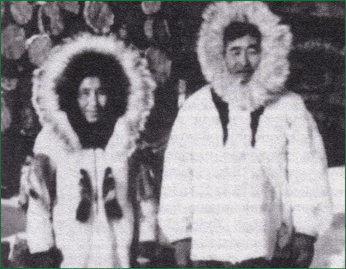 In the case of a woman ready to give birth to a child, people took her away from the camp so that she could have the baby by herself. I have heard that sometimes when a woman did not have a knife to cut with, she had to chew on the umbilical cord in order to cut it off. The floors in those days were made of spruce boughs or willow twigs. This is what the baby was born into. After four days had passed, the woman was allowed to go back home, but she had to live behind a curtain for one month after having the baby.
In the case of a woman ready to give birth to a child, people took her away from the camp so that she could have the baby by herself. I have heard that sometimes when a woman did not have a knife to cut with, she had to chew on the umbilical cord in order to cut it off. The floors in those days were made of spruce boughs or willow twigs. This is what the baby was born into. After four days had passed, the woman was allowed to go back home, but she had to live behind a curtain for one month after having the baby.
It is amazing that women did not become ill from the cold in those days. It certainly was not an easy life back then. Shamans helped heal people, but they did not have modern medicine. To bandage wounds people used caribou hide or partially tanned caribou hide. A common medicinal plant was the sargibruaq also called stink-weed. Cranberries were used to heal sores and sore throats. Today, cranberries are still used for medicinal purposes.
People also kept a supply of dried porcupine drop-pings for medicinal use. They were soaked in water to cure diarrhea. Wild rhubarb was also used to stop diarrhea. It is an effective medicine if eaten without seal oil. If blood letting was not used to cure a headache, then a piece of string was tied around a person's head. For serious illnesses a shaman was consulted.
When people dried fish during the summer, they saved the salmon and sheefish heads. These were preserved by being buried in the ground between layers of grass. This was once a popular delicacy that is not enjoyed as much nowadays. It was comparable to the fermented seal flippers enjoyed by the Eskimos who live along the coast.
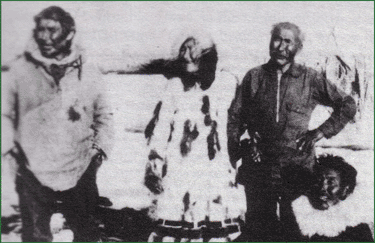 These are examples of food that were gathered and preserved in order to survive. In those days there was no white man's food to supplement the diet. People did not even cook with salt in those days. Their platters and buckets were made of wood. The women also made clay pots. I can remember when wooden buckets were still in use. I recall that we used to make sourdough batter in those wooden buckets.
These are examples of food that were gathered and preserved in order to survive. In those days there was no white man's food to supplement the diet. People did not even cook with salt in those days. Their platters and buckets were made of wood. The women also made clay pots. I can remember when wooden buckets were still in use. I recall that we used to make sourdough batter in those wooden buckets.
Life certainly was not easy in those days. People worked hard just in order to live. Today we live like rich people because of the introduction of western goods. Nowadays we don't even haul water or dump slop pails.
Lighting, too, is readily available. In the early days people took their oil lamps with them whenever they left their house. Or they hid the lamp in case someone would enter the empty house. People treasured their oil lamps in those days. Perhaps it was not very easy to make a lamp. Seal oil or fish oil was the fuel they used.
People back then had no matches. They used flint to start a fire. They most likely gathered cotton to use as a fire starter. They used the tips of cotton grass for this purpose. They were used to help get a fire going when flint was used. I wonder how long the fire was kept going. The fire itself was in the middle of the house.
In order to cook, people heated rocks. When they turned red hot, they were placed into the water in a pot. This was probably because they could not put their pots directly over the fire. If they wanted to eat something well cooked, four stones were used one right after the other to boil the water. Another way of cooking was to place fish on roasting spits over an open fire. They probably had some oil to go with their food since they did travel to the coast either to hunt seals or to trade for seal oil.
There is a lot more to tell about the old days. They say, for example, that there were many shamans then. There was even a prophet by the name of Maniiļauraq. Many of his prophesies have come true. That is all I have to tell for now.

